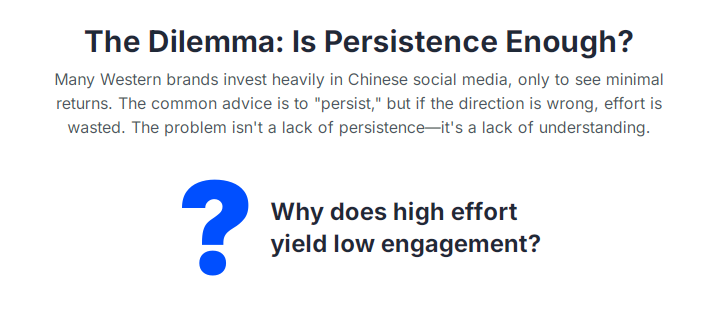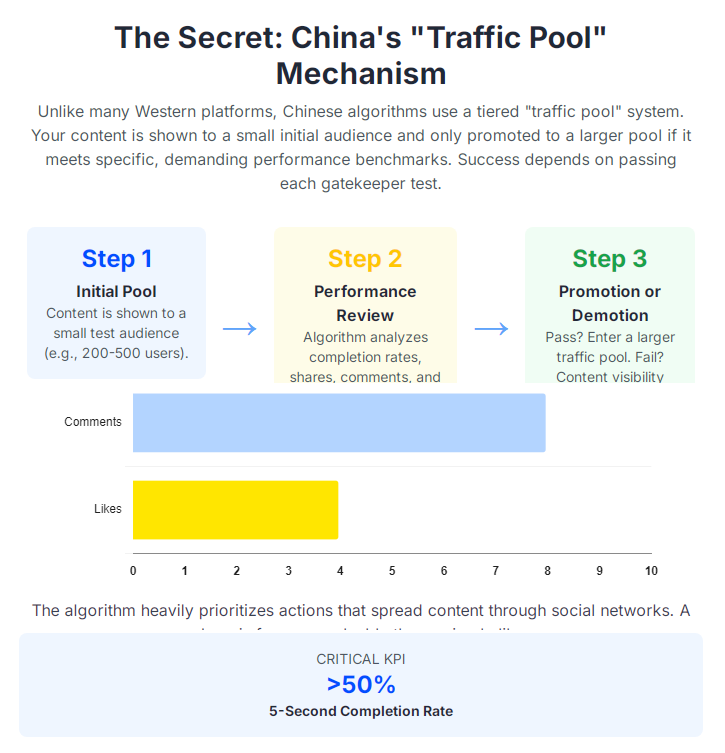Cracking the Code: A Visual Guide to China’s Social Media Algorithms
For many Western brands venturing into China’s vibrant digital landscape, the experience can be perplexing. Despite significant investment in self-media platforms like WeChat, Douyin, and Xiaohongshu, the results often fall short of expectations: dismal readership, minimal likes, and scarce shares. This leads to a common, frustrating question: “Does persisting even make sense?”

The conventional wisdom of “just keep going” often rings hollow when the underlying strategy is misaligned. The core issue isn’t a lack of effort, but a fundamental misunderstanding of China’s unique digital ecosystem. Unlike Western platforms, where content might gain broad exposure from the outset, Chinese platforms operate on a sophisticated, often opaque, algorithmic system centered around “traffic pools.” This report aims to demystify this “black box,” providing a practical guide for Western brands to move from blind persistence to data-driven, precise marketing.
The Algorithmic Gatekeepers: Understanding Traffic Pools
China’s digital giants, including Tencent and ByteDance, have developed highly advanced, AI-driven algorithms that are constantly evolving. These systems are resilient, even adapting to external challenges like chip export controls through “architectural innovation, efficiency, and open-source collaboration”. Success in this environment demands more than just translating content; it requires a deep mastery of each platform’s technical and algorithmic infrastructure.

The defining feature of Chinese self-media is its “traffic pool” or “tiered recommendation” system. Instead of immediate broad distribution, content is first introduced to a small, initial audience. Only if it performs well at this stage does it gain access to larger pools. For example:
- Douyin videos begin in a “cold start” pool, reaching “300-500 views” from followers, friends, and tag-matched users.
- Xiaohongshu notes, once indexed, enter an “initial traffic pool” for “200 to 500 exposures” to test performance.
- WeChat Video Accounts use a “three-stage mechanism” (recall, ranking, mixed ranking) with clear “traffic pool tiers,” escalating from an “initial layer (50-200)” to a “viral layer (≥10 million)”.
Platforms explicitly state that content must “meet data benchmarks” to “enter the next layer”. Failure means the content “sinks,” losing visibility. This gatekeeper logic means content must pass initial performance tests to earn wider distribution, prioritizing content that shows high quality and strong engagement signals early on.
Beyond Engagement: What Algorithms Really Value
While global platforms use algorithms, China’s explicit tiered “traffic pool” model and its clear (though unofficial) thresholds are a key differentiator. Moreover, China’s proactive regulatory environment significantly influences algorithm design. China was “the first nation to issue laws regulating algorithms and generative AI” , addressing issues like “big data swindling” (algorithmic discrimination) and platform monopolies. This means algorithms are not purely commercial tools; they are also shaped by state policies, content control (e.g., preventing “vulgar content” ), and broader societal goals. Foreign brands must integrate a deep understanding of China’s regulatory and socio-political context into every layer of their content strategy.
Here’s a breakdown of what each major platform truly values:
- WeChat Video Accounts: These prioritize “shares > comments > likes” , emphasizing active dissemination. Crucially, content must meet strict thresholds: “overall completion rate > 28%”, “5-second completion rate > 50%”, and “2-second bounce rate < 28%”. The first few seconds are paramount.
- WeChat Official Accounts: The algorithm here values “readership rate, post-read follow rate, and reading duration”. It’s more SEO-like, with “keyword density in title/body” and “historical search term matching” being vital for discoverability. Account credibility, reflected in a “low complaint rate,” also contributes to “high weight”.
- Xiaohongshu: This platform uses a unique CES (Community Engagement Score) algorithm: “1 point for a like + 1 point for a save + 4 points for a comment + 4 points for a share + 8 points for a follow”. This clearly weights deep interactions and community building. Authenticity and originality are core.
- Douyin: Designed for rapid virality, its core metrics are weighted: “completion rate > shares > comments > likes”. The “first 5 videos determine account weight” , making initial content quality critical. A “3%-5% like rate” can trigger a second round of recommendations.
- Bilibili: This platform rewards “completion rate, coin-toss, saves, and shares”. “Coin-toss” (direct financial support) is a unique signal of high user approval. Bilibili favors “content depth > entertainment” and “supports long videos (knowledge-based content ≥10 minutes has weighted advantage)”.
The Dual Strategy: Public Discovery Meets Private Loyalty
A truly effective strategy in China isn’t about choosing between public and private platforms, but integrating them seamlessly.
- Public Platforms (Douyin, Xiaohongshu, WeChat Video Accounts): These are excellent for “customer acquisition” and “discovery” through algorithmic reach. They generate initial awareness and fill the top of your marketing funnel.
- Private Domains (WeChat Official Accounts, WeChat Groups, Personal WeChat Accounts): These are crucial for “retention,” “loyalty,” and “conversion”. Here, brands can directly control communication, manage user relationships, and build deeper connections without third-party platform costs.
“Fission” marketing is a uniquely Chinese growth method within private domains. It involves designing closed-loop mechanisms (sharing → conversion) with strong incentives (e.g., group buying, unlocking, distribution sales). WeChat, in particular, is a hub for “private groups and VIP marketing” , fostering intimate, hyper-personalized interactions. This dual approach creates a self-reinforcing, sustainable digital ecosystem where public platforms drive initial interest, and private domains capture, nurture, and convert audiences into loyal customers.
Building Trust: The Algorithmic “Trust Ladder”
The progression through traffic pools is akin to building trust in human relationships or achieving high SEO rankings. Just as search engines gradually build trust with websites, Chinese social media algorithms build “account weight” or “account credibility” through consistent high-quality content, active user interaction, and adherence to platform guidelines.
This accumulated “trust” or “authority” influences the initial reach of new content and its potential to progress through traffic pools. It’s a long-term investment in digital credibility. Brands should prioritize building this algorithmic reputation through:
- Consistency and Quality: Regularly publishing “high-quality, original content”.
- Authenticity and Value: Providing genuine value, avoiding “overly promotional or spammy content”.
- Active Community Engagement: Promptly “responding to comments and messages” and “encouraging interaction”.
- Platform Compliance: Strictly adhering to guidelines to avoid penalties.
- Vertical Deep Cultivation: Specializing in niche areas to build authority, especially on platforms like WeChat Official Accounts and Bilibili.
Your Roadmap to Success
For Western brands, navigating China’s digital landscape requires a strategic, data-driven approach:
- Strategic Platform Selection: Choose platforms based on your content type, target audience, and business goals. “Low-competition, high-turnover” platforms like WeChat Official Accounts (for long-tail search) and Xiaohongshu (with its “high fault tolerance” tiered recommendation) are good for “cold start” strategies. Douyin and WeChat Video Accounts demand “strong viral content” for broad reach , while Bilibili suits “vertical deep content”.
- Data-Driven Localized Content: Use social analytics to inform your content strategy. Engage in “social listening” to understand audience interests and pain points, optimizing content accordingly. Integrate SEO keyword research into your social media content. Focus on creating “high-quality, original content” that provides genuine value.
- Continuous Monitoring and Adaptation: Chinese algorithms are “constantly learning and evolving”. This dynamic environment demands continuous monitoring of performance metrics and agile strategy adjustments. Localized expertise, whether in-house or through partnerships with specialized Chinese digital marketing agencies, is indispensable for navigating algorithmic nuances, complex regulations, and cultural sensitivities.
In conclusion, success for Western brands in China’s self-media landscape is not a matter of blind persistence, but a strategic endeavor rooted in understanding and mastering the “traffic recommendation code.” By embracing data-driven diagnostics, platform-specific content optimization, strategic integration of public and private traffic, and the long-term cultivation of algorithmic trust, brands can unlock immense opportunities in this challenging yet rewarding digital ecosystem.
